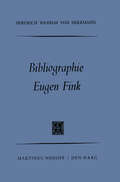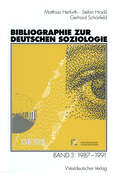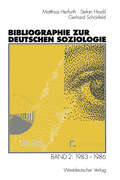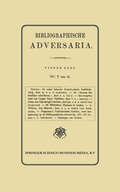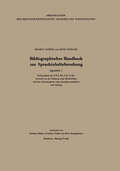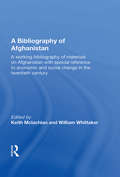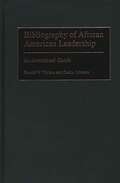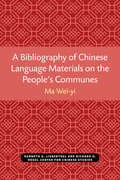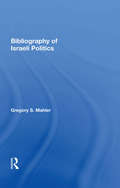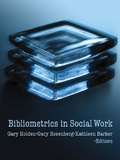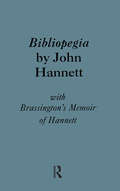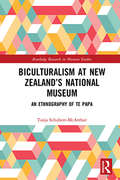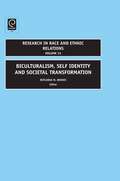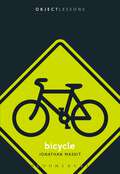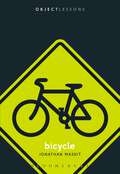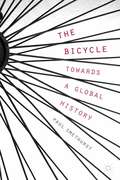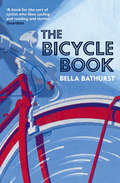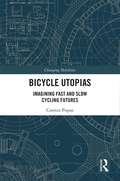- Table View
- List View
Bibliographie Gefängnisseelsorge (Studien und Materialien zum Straf- und Massregelvollzug)
by Peter RassowBibliographie zur deutschen Soziologie: Band 3: 1987 – 1991
by Matthias Herfurth Stefan Hradil Gerhard SchönfeldDiese Bibliographie - entstanden aus der Datenbank SOLIS (Sozialwissenschaftliches Literaturinformationssystem) - besteht aus mehreren Bänden, die in rascher Folge erscheinen werden bzw. bereits erschienen sind (Band 1 und 2 sind Anfang 1998 herausgegeben worden, Band 3 ist in Vorbereitung wird in Kürze folgen). Sie enthält die soziologische Fachliteratur ab dem Erscheinungsjahr 1978 und schließt an eine frühere Publikation gleichen Namens ('Bibliographie zur Deutschen Soziologie 1945-1977') an. Im Band 1 (1978-1982) werden über 14.000 selbständige und unselbständige Veröffentlichungen aus dem gesamten deutschsprachigen Raum nachgewiesen. Der Band 2 umfaßt die Jahre 1983-1986 und enthält ca. 14.900 Literaturnachweise. Band 3 wird etwa 15.600 Nachweise enthalten. Jeder Band ist inhaltlich in drei Abschnitte (Grundlagen und Methoden, Spezielle Soziologie, Sozialpsychologie) und insgesamt 29 Kapitel untergliedert. Die Bibliographie wird (neben der Kapitelgliederung) durch ein umfassendes Personenregister, ein Institutionenregister sowie durch ein zweistufiges Sachregister erschlossen, das sich auf den vom Informationszentrum Sozialwissenschaften entwickelten Thesaurus der sozialwissenschaftlichen Fachterminologie stützt und alle in ihm enthaltenen Sachgebiete berücksichtigt.
Bibliographie zur deutschen Soziologie: Band 2: 1983–1986
by Matthias Herfurth Stefan Hradil Gerhard SchönfeldDiese Bibliographie - entstanden aus der Datenbank SOLIS (Sozialwissenschaftliches Literaturinformationssystem) - enthält die soziologische Fachliteratur der Erscheinungsjahre 1983 bis 1986. In ihr werden fast 15.000 selbständige und unselbständige Veröffentlichungen aus dem gesamten deutschsprachigen Raum nachgewiesen. Die Bibliographie ist inhaltlich in drei Abschnitte (Grundlagen und Methoden, Spezielle Soziologie, Sozialpsychologie) und insgesamt 29 Kapitel untergliedert. Mit dieser Veröffentlichung wird die Reihe soziologischer Bibliographien fortgesetzt, die mit der im Jahr 1997 herausgegebenen "Bibliographie zur deutschen Soziologie 1978 - 1982" neu begründet wurde und bis auf die 1980 erschienene "Bibliographie zur deutschen Soziologie 1945 - 1977" zurückgeht. Die Bibliographie wird (neben der Kapitelgliederung) durch ein umfassendes Personenregister, ein Institutionenregister sowie durch ein zweistufiges Sachregister erschlossen, das sich auf den vom Informationszentrum Sozialwissenschaften entwickelten Thesaurus der sozialwissenschaftlichen Fachterminologie stützt und alle in ihm enthaltenen Sachgebiete berücksichtigt.
Bibliographisches Handbuch zur Sprachinhaltsforschung: Beiheft 1 (Arbeitsgemeinschaft für Forschung des Landes Nordrhein-Westfalen #16a / Beiheft 1)
by Helmut Gipper Hans Schwarz Hartmut Beckers Kristina Franke Horst SprengelmeyerNach Abschluß des zweiten Bandes (Lfg. 8-16, H-K) von Teil I des Handbuchs legen wir nun - ungefähr in der Mitte des Verfasseralphabets haltend - als vorläufiges Hilfsmittel für den Benutzer und als Probe auf Teil II des Werkes einen repräsentativen Querschnitt durch den geplanten Registerband vor. Der hierfür anstehende Stoff wird dabei auf zwei gesonderte Beihefte verteilt: Beiheft 1 (vorliegendes Heft) bringt neben dem für beide Hefte gültigen Verzeichnis der bei den Sprachangaben angewandten Abkürzungen eine vorwiegend nach dem Ge sichtspunkt der Ergiebigkeit für künftige Feldstudien getroffene Auswahl aus der Ord nung nach Sinnbezirken (B) und einen als zusätzliche Informationsquelle gedachten Auszug aus dem spezifizierenden Namenregister (C) sowie ferner als Anhang allfällige Ergänzungen zur Zeitschriftenbibliographie (S. CXV -CCIV), zum Rezensionsverzeich nis (S. CXIV) und zur Besetzung des Mitarbeiterstabes (S. CXIII). - In beiden Re gistern (B und C) ist innerhalb der einzelnen Ausschnitte der in Band 1-11 gebotene Stoff vollständig und - mit Ausnahme der von H. BECKERS bearbeiteten Gebiete - auch unter Ausnutzung der Verweise auf die zweite Alphabethälfte ausgewertet. Darüber hinaus sind in der Ordnung nach Sinnbezirken probeweise auch (gemäß Einl. , S. XCIII) bereits die inzwischen angefallenen Nachträge zu A-K eingearbeitet. Beiheft 2 (voraussichtlich im Herbst 1974 erscheinend) wird dann- allerdings unter Verzicht auf die Nachträge- das in sich selbst vollständige alphabetische Sach- und Problemregister (A) zu Band 1-11 und gegebenenfalls, sofern noch Raum verfügbar, eine Liste der im Handbuch von den Bearbeitern beiläufig gegebenen Erklärungen ein zelner Wörter oder Redewendungen (D) enthalten.
A Bibliography Of Afghanistan
by K. S. McLachlanThis up-to-date, comprehensive, thematically indexed bibliography devoted to Afghanistan now and yesterday will help readers to efficiently find their way in the massive secondary literature available. Following the pattern established by one of its major data sources, viz. the acclaimed Index Islamicus, both journal articles and book publications are included and expertly indexed. An indispensable entry for all those taking professional or personal interest in a nation so much the focus of attention today.
A Bibliography Of Afghanistan
by K. S. McLachlanThis up-to-date, comprehensive, thematically indexed bibliography devoted to Afghanistan now and yesterday will help readers to efficiently find their way in the massive secondary literature available. Following the pattern established by one of its major data sources, viz. the acclaimed Index Islamicus, both journal articles and book publications are included and expertly indexed. An indispensable entry for all those taking professional or personal interest in a nation so much the focus of attention today.
Bibliography of African American Leadership: An Annotated Guide (Bibliographies and Indexes in Afro-American and African Studies)
by Cedric Johnson Ronald W. WaltersCompiled in this volume is the most significant accumulation of works on the subject of African American leadership to date. As the field of leadership studies continues to grow, this timely work contributes to an understanding of the activities of those people and organizations that have been leaders of people of African descent and have contributed to the cultural and political affairs of the black community, as well as the representation of the black community in mainstream American life. The annotated entries cover a variety of works on subjects such as dedicated black leadership studies, local descriptions and analyses, biographies, leadership organizations, and audio-visual materials. This reference is an important contribution to the field of leadership studies in general, and African American leadership in particular, and will serve as a valuable research tool for educators and practitioners alike.The entries are organized into six sections, which offer a broad overview of the various aspects of African American leadership. Part I, Critical Studies and Appraisals, focuses on the history of works dedicated to both national and local leaders and their politically relevant activities. The next section, Local Leadership Studies, is organized around black leaders who served local communities and the various issues they addressed. Part III looks at relevant social movements and ideologies that have highlighted the activities of black leaders. Individual leaders who have made contributions to the political life of the black community are included in Part IV, while leadership organizations are highlighted in Part V. The concluding section of the volume looks at available audio-visual materials. A thorough index rounds out the bibliography.
A Bibliography of Chinese Language Materials on the People's Communes (Michigan Monographs In Chinese Studies #44)
by Wei-yi MaA research tool for scholars studying modern China, particularly those focusing on the post-1949 communal system and economy. The work includes full bibliographic references to some 2,800 essay, articles, pamphlets, and other materials in Chinese taken from more than 130 publications, primarily from mainland. The entries are arranged are arranged topically with annotations. Includes a geographic index to the communes referred to in the listed items.
Bibliography Of Israeli Politics
by Gregory S. MahlerThis bibliography is a response to the problems facing students and scholars of Israeli politics who need to find the most current resources for their research. A readily accessible and comprehensive listing of published works dealing with Israeli politics, the bibliography includes studies on the Israeli constitutional system; Israel’s elections, political history, and economics; its diplomatic relations and foreign policy; and Zionism. Also included are studies of related topics such as Palestine and the Palestinian people, the resolution of the West Bank and Gaza Strip question, and the Arab-Israeli peace process. The book contains a detailed keyword index to nearly 1,500 entries, citing books and journal articles published in the United States, Europe, and Israel.
Bibliography Of Israeli Politics
by Gregory S. MahlerThis bibliography is a response to the problems facing students and scholars of Israeli politics who need to find the most current resources for their research. A readily accessible and comprehensive listing of published works dealing with Israeli politics, the bibliography includes studies on the Israeli constitutional system; Israel’s elections, political history, and economics; its diplomatic relations and foreign policy; and Zionism. Also included are studies of related topics such as Palestine and the Palestinian people, the resolution of the West Bank and Gaza Strip question, and the Arab-Israeli peace process. The book contains a detailed keyword index to nearly 1,500 entries, citing books and journal articles published in the United States, Europe, and Israel.
Bibliometrics in Social Work
by Gary Holden Gary Rosenberg Kathleen BarkerBibliometrics in Social Work examiness the cross-disciplinary field of bibliometrics, including the multiple techniques and applications that have been described in the scholarly literature. Moving beyond this general overview, the authors examine applications of bibliometrics in social work. Subsequent chapters detail how the technique can be used to demonstrate the eventual impact on the field of publications in selected journals. These analyses are conducted using the bibliometric technique referred to as citation analysis. The authors then move on to present what will be a controversial proposal to some in the field: using bibliometrics techniques in making academic personnel decisions. The authors propose that hiring, retention, tenure and promotion decisions could be made more uniform and fair by using citation analysis. A series of experts in bibliometric analyses then critically respond to these initial chapters. The authors conclude by weaving their responses to these commentators with new scholarship on bibliometrics that has recently appeared. This unique book is a valuable aid for social work scholars. Drawing on broad interdisciplinary streams of scholarship from around the world, the collection illuminates a field that is not well known to social workers. While cautiously advocating for a number of applications of the technique, the authors balance this position by presenting a comprehensive summary of the criticisms of the technique and by the inclusion of a series of critical commentaries by the leading experts on these issues in the field of social work. Bibliometrics in Social Work both summarizes what we know and pushes the field to think about how social work professionals can use this approach to improve our scholarship and the evaluation of scholars. Bibliometrics in Social Work addreses: theoretical and methodological issuess pros and cons from the view of numerous bibliometric scholars bibliometrics outside of social work applications within social work previously reported in the literature estimates that have been reported in the literature of how much social workers publish and how much impact those publications have had how citation analysis can be used to analyzed a selection of publications in a single journal and their subsequent impact how citation analysis might be used to improve academic employment decisions concerns regarding self-citation and multiple authorship measurement issues in bibliometrics (e.g., age adjustments; concentration citedness, and uncitedness; the Price Index; lag times; persistence; synchronous and diachronous self-citations; the Multiple Author Qualifier) Bibliometrics in Social Work critically examines these methods and their applications in social work. The book will be an enlightening read for social work scholars and those academic administrators involved in the evaluation of social work scholars, as well as academic librarians that support social work programs.
Bibliometrics in Social Work
by Gary Rosenberg Kathleen BarkerBibliometrics in Social Work examiness the cross-disciplinary field of bibliometrics, including the multiple techniques and applications that have been described in the scholarly literature. Moving beyond this general overview, the authors examine applications of bibliometrics in social work. Subsequent chapters detail how the technique can be used to demonstrate the eventual impact on the field of publications in selected journals. These analyses are conducted using the bibliometric technique referred to as citation analysis. The authors then move on to present what will be a controversial proposal to some in the field: using bibliometrics techniques in making academic personnel decisions. The authors propose that hiring, retention, tenure and promotion decisions could be made more uniform and fair by using citation analysis. A series of experts in bibliometric analyses then critically respond to these initial chapters. The authors conclude by weaving their responses to these commentators with new scholarship on bibliometrics that has recently appeared. This unique book is a valuable aid for social work scholars. Drawing on broad interdisciplinary streams of scholarship from around the world, the collection illuminates a field that is not well known to social workers. While cautiously advocating for a number of applications of the technique, the authors balance this position by presenting a comprehensive summary of the criticisms of the technique and by the inclusion of a series of critical commentaries by the leading experts on these issues in the field of social work. Bibliometrics in Social Work both summarizes what we know and pushes the field to think about how social work professionals can use this approach to improve our scholarship and the evaluation of scholars. Bibliometrics in Social Work addreses: theoretical and methodological issuess pros and cons from the view of numerous bibliometric scholars bibliometrics outside of social work applications within social work previously reported in the literature estimates that have been reported in the literature of how much social workers publish and how much impact those publications have had how citation analysis can be used to analyzed a selection of publications in a single journal and their subsequent impact how citation analysis might be used to improve academic employment decisions concerns regarding self-citation and multiple authorship measurement issues in bibliometrics (e.g., age adjustments; concentration citedness, and uncitedness; the Price Index; lag times; persistence; synchronous and diachronous self-citations; the Multiple Author Qualifier) Bibliometrics in Social Work critically examines these methods and their applications in social work. The book will be an enlightening read for social work scholars and those academic administrators involved in the evaluation of social work scholars, as well as academic librarians that support social work programs.
Bibliopegia
by John Hannett W. S. BrassingtonA part of the history of bookbinding collection-A series of reprint volumes, original monographs, and translations relating to the history of bookbinding. This volume includes a Bibliopegia of bookbinding in two parts- The ‘Books of the Ancients and History of the Art of Bookbinding’. and in part two, ‘The practical art of bookbinding’. This edition includes Brassington’s memoir of Hammett.
Bibliopegia: Or The Art Of Bookbinding, In All Its Branches (Cambridge Library Collection - History Of Printing, Publishing And Libraries Ser.)
by John Hannett W. S. BrassingtonA part of the history of bookbinding collection-A series of reprint volumes, original monographs, and translations relating to the history of bookbinding. This volume includes a Bibliopegia of bookbinding in two parts- The ‘Books of the Ancients and History of the Art of Bookbinding’. and in part two, ‘The practical art of bookbinding’. This edition includes Brassington’s memoir of Hammett.
Bichitra: The Making of an Online Tagore Variorum (Quantitative Methods in the Humanities and Social Sciences)
by Sukanta ChaudhuriThis book documents the creation of the Bichitra Online Tagore Variorum, a publicly accessible database of Rabindranath Tagore's complete works in Bengali and English totaling some 140,000 pages of primary material. Chapters cover innovative aspects of the site, all replicable in other projects: a hyperbibliography; a search engine and hyperconcordance working across the database; and a unique collation program comparing variant texts at three levels. There are also chapters on the special problems of processing manuscripts, and on planning the website. Early chapters take readers through the history of the project, an overview of Tagore’s works, and the Bengali writing system with the challenges of adapting it to electronic form. The name Bichitra, meaning "various" in Bengali, alludes both to the great variety of Tagore’s works and to their various stages of composition. Beyond their literary excellence, they are notable for their sheer quantity, the number of variant forms of a great many items, and their afterlife in translation, often the poet’s own. Seldom if ever has the same writer revised his material and recast it across genres on such a scale. Tagore won the Nobel Prize in 1913. By its value-added presentation of this range of material, Bichitra can be a model for future databases covering an author’s complete works or other major corpus of texts. It offers vastly expanded access to Tagore’s writings, and enables new kinds of research including computational text analysis. The “book of the website” shows in technical and human terms how researchers with interests in art, literature and technology can collaborate on cultural informatics projects.
Biculturalism at New Zealand’s National Museum: An Ethnography of Te Papa (Routledge Research in Museum Studies)
by Tanja Schubert-McArthurThe Museum of New Zealand Te Papa Tongarewa has been celebrated as an international leader for its bicultural concept and partnership with Māori in all aspects of the museum, but how does this relationship with the indigenous partner work in practice? Biculturalism at New Zealand’s National Museum reveals the challenges, benefits and politics of implementing a bicultural framework in everyday museum practice. Providing an analysis of the voices of museum employees, the book reflects their multifaceted understandings of biculturalism and collaboration. Based on a year of intensive fieldwork behind the scenes at New Zealand’s national museum and drawing on 68 interviews and participant observations with 18 different teams across the organisation, this book examines the interactions and cultural clashes between Māori and non-Māori museum professionals in their day-to-day work. Documenting and analysing contemporary museum practices, this account explores how biculturalism is enacted, negotiated, practised and envisioned on different stages within the complex social institution that is the museum. Lessons learnt from Te Papa will be valuable for other museums, NGOs, the public service and organisations facing similar issues around the world. Biculturalism at New Zealand’s National Museum addresses a gap in the literature on biculturalism and reaffirms the importance of ethnography to the anthropological enterprise and museum studies research. As such, it will be essential reading for academics, researchers and postgraduate students in the fields of cultural anthropology, museum anthropology, museum studies, and Māori studies or indigenous studies. It should also be of great interest to museum professionals.
Biculturalism at New Zealand’s National Museum: An Ethnography of Te Papa (Routledge Research in Museum Studies)
by Tanja Schubert-McArthurThe Museum of New Zealand Te Papa Tongarewa has been celebrated as an international leader for its bicultural concept and partnership with Māori in all aspects of the museum, but how does this relationship with the indigenous partner work in practice? Biculturalism at New Zealand’s National Museum reveals the challenges, benefits and politics of implementing a bicultural framework in everyday museum practice. Providing an analysis of the voices of museum employees, the book reflects their multifaceted understandings of biculturalism and collaboration. Based on a year of intensive fieldwork behind the scenes at New Zealand’s national museum and drawing on 68 interviews and participant observations with 18 different teams across the organisation, this book examines the interactions and cultural clashes between Māori and non-Māori museum professionals in their day-to-day work. Documenting and analysing contemporary museum practices, this account explores how biculturalism is enacted, negotiated, practised and envisioned on different stages within the complex social institution that is the museum. Lessons learnt from Te Papa will be valuable for other museums, NGOs, the public service and organisations facing similar issues around the world. Biculturalism at New Zealand’s National Museum addresses a gap in the literature on biculturalism and reaffirms the importance of ethnography to the anthropological enterprise and museum studies research. As such, it will be essential reading for academics, researchers and postgraduate students in the fields of cultural anthropology, museum anthropology, museum studies, and Māori studies or indigenous studies. It should also be of great interest to museum professionals.
Biculturalism, Self Indentity and Societal Development (Research in Race and Ethnic Relations #15)
by Rutledge M. DennisWhen a society or nation contains many cultures, large or small, with differing institutional and organizations networks, individuals and groups must, in order to successfully navigate their passages within and between cultures, learn to act and react to primary and secondary cultural orientations, which might be labeled dominant and super-ordinate or non-dominant and sub-ordinate. Under such a scenario, biculturalism exists. The essays in this volume offer fresh theoretical and methodological insights into biculturalism as an existing reality in many socieities. The authors present a variety of methodological strategies and techniques case studies, autoethnography, content analysis, participant observation, the national survey, and structured and unstructured interviews. Whereas some essays provide a brief history as a point of reference to aid the reader in understanding how and why biculturalism began and persists the beginning of biculturalism, others do not.All essays, whether written from social science or humanity perspectives, give the readers a glimpse into the bicultural world of a particular people or group. Hence, biculturalism is presented as it illustrates the world of the following: a female African American intellectual; German, Koreans, and Japanese immigrants, Koreans; South Asians; two autoethnographic bicultural case studies; issues of identity and biculturalism among Asians, Native Americans, whites, and African Americans in the U.S.; and, a content analysis of Spanish language programs for children, and essays analyzing biculturalism among Jewish Americans and African Americans, and a critique of Ralph Ellison's bicultural imperatives.Many of the essays will analyze class, ethnic, and gender issues as they relate to the idea of biculturality. The essays in this volume relate the bicultural experience and remind the reader that this bicultural experience may connect to ideas of acculturation, assimilation, marginality, identity, ambivalence, super-ordinate, sub-ordination, and issues related to insiders and outsiders, but a crucial theme in biculturalism is the existence of two cultural streams and the fact that individuals and groups may, over time, operate in both streams, and deftly move within and between each, as opportunities present themselves.
Bicycle (Object Lessons)
by Dr Jonathan MaskitObject Lessons is a series of short, beautifully designed books about the hidden lives of ordinary things. These days the bicycle often appears as an interloper in a world constructed for cars. An almost miraculous 19th-century contraption, the bicycle promises to transform our lives and the world we live in, yet its time seems always yet-to-come or long-gone-by. Jonathan Maskit takes us on an interdisciplinary ride to see what makes the bicycle a magical machine that could yet make the world a safer, greener, and more just place.Object Lessons is published in partnership with an essay series in The Atlantic.
Bicycle (Object Lessons)
by Dr Jonathan MaskitObject Lessons is a series of short, beautifully designed books about the hidden lives of ordinary things. These days the bicycle often appears as an interloper in a world constructed for cars. An almost miraculous 19th-century contraption, the bicycle promises to transform our lives and the world we live in, yet its time seems always yet-to-come or long-gone-by. Jonathan Maskit takes us on an interdisciplinary ride to see what makes the bicycle a magical machine that could yet make the world a safer, greener, and more just place.Object Lessons is published in partnership with an essay series in The Atlantic.
The Bicycle — Towards a Global History: Towards A Global History
by P. SmethurstThis is the first history of the bicycle to trace not only the technical background to its invention, but also to contrast its social and cultural impact in different parts of the world, and assess its future as a continuing global phenomenon.
The Bicycle Book
by Bella BathurstA rip-roaring narrative celebration of the 21st century’s great transport success story: the bicycle. Millions of us now cycle, some obsessively, and this glorious concoction of history, anecdote, adventure and lycra-clad pedalling is the perfect read for two-wheelers of all kinds.
Bicycle Utopias: Imagining Fast and Slow Cycling Futures (Changing Mobilities)
by Cosmin PopanBicycle Utopias investigates the future of urban mobilities and post-car societies, arguing that the bicycle can become the nexus around which most human movement will revolve. Drawing on literature on post-car futures (Urry 2007; Dennis and Urry 2009), transition theory (Geels et al. 2012) and utopian studies (Levitas 2010, 2013), this book imagines a slow bicycle system as a necessary means to achieving more sustainable mobility futures. The imagination of a slow bicycle system is done in three ways: Scenario building to anticipate how cycling mobilities will look in the year 2050. A critique of the system of automobility and of fast cycling futures. An investigation of the cycling senses and sociabilities to describe the type of societies that such a slow bicycle system will enable. Bicycle Utopias will appeal to students and scholars in fields such as sociology, mobilities studies, human geography and urban and transport studies. This work may also be of interest to advocates, activists and professionals in the domains of cycling and sustainable mobilities.
